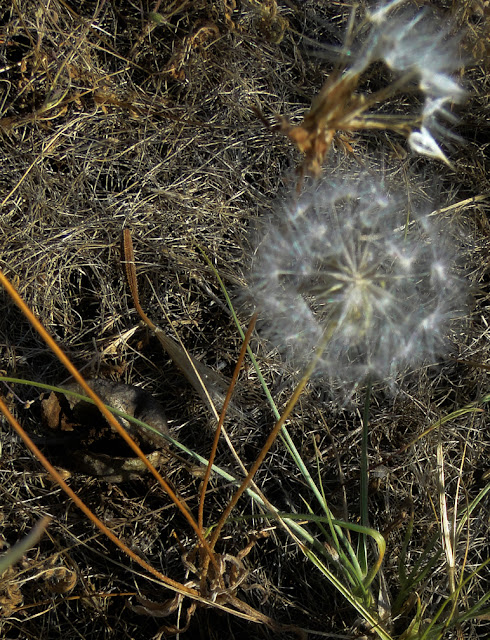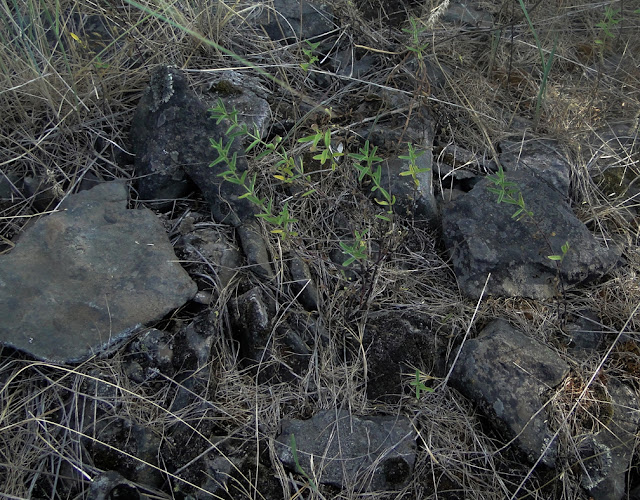7/17/2012 7:10:02 PM
Out about 4:30 pm. 2 hours. 149 images. 84 keepers. Hot. Occasional light gusts. Comfortable in the shade.
New find: Trifolium arvense, hare’s foot clover, Fabaceae family, introduced.
*
I was surprised at the length of the ‘hunt list’ I made up for this walk.
I broke it into pieces to be accessed from different parking places. Part of the idea was that I would not be out in the heat, long or take a lot of photos I would have to process.
I would leave some of the hunt list for another visit in a couple of days.
It turned out that I only parked in two places, stayed out too long and took too many photos but what else is new?
I did leave some for next time.
I haven’t processed any photos yet, just loaded them into the computer and sorted them into folders.
*
I set the camera at 1/400th of a second and, as usual, forgot about it. Some photos I took later were disasters probably from weaker light. But also because of weaker patience. The photos got worse as the day wore on. Unfortunately some of the inadequate photos were of plants of particular interest.
*
I was disappointed at my lack of strength. I didn’t feel good from the beginning even though I supposed I was fully rested. Getting down to make photographs and getting backup again was far more difficult than it should have been from the first.
*
I parked at the north entrance to check the Chondrilla juncea, rush skeleton weed, Centaurea diffusa, the white knapweed and Conyza canadensis, Canadian horseweed along the top end of the north-side trail.
There was a Centaurea diffusa in bloom right by my parking place but it was broken. There were more beginning to bloom on down the north trail. No sign of bud or blossom on Chondrilla juncea. No sign of Conyza canadensis at all.
I was unwilling to get a ‘plant photo’ of the white knapweed. It was too difficult. I just took a snapshot of the patch and hoped a short branch photo would substitute for a ‘plant photo’.
*
Below the white knapweed patch I saw a cricket! I assumed it was dead. I took a ‘snapshot’ of it, in case it wasn’t dead and reached to pick it up.
It wasn’t dead. When I tried to pick it up it leaped away with quick, amazingly high bounding hops.
There are a few grasshoppers in the park. It doesn’t seem to me that there are as many as there ought to be.
It was not a day for chasing grasshoppers with my camera.
*
I saw white knapweed in bloom around town for some time before it bloomed here.
I saw a Portulaca oleraceae, purslane in bloom in north-east Spokane
*
Perideridia gairdneri, yampah is in partial bloom all over the park.
*
I couldn’t resist searching yet again for the presumably lost Erigeron speciosus, showy fleabane in the open field at the south-east corner of the park.
I parked back from the corner some distance to leave the car in the shade and, as a result, noticed two plants blossoming across
Ash Court
. The area is a continuation of the park, down the hill to
Ash Street
. The spring is near Ash. I have almost never walked down there but I’m willing to count it as part of the study area, if not now … someday. It’s shady and much wetter than the rest of the park.
*
I have seen Convolvulus arvensis, bindweed or morning glory all over town for some time but none on my walks in the park. However, I have not got to the west end of the park recently. That’s where I saw it last year. This patch was very healthy [unlike the patch at the west end of the park last year] and had obviously been in bloom for some time.
*
Next to it was a patch of a Silene species. Burke has 16 species of Silene, some native, most introduced. Some are natives in Spokane County
*
When I did my search of the field at the southeast corner of the park I saw a couple of little dried up plants with balls of seeds on them that might have been my ‘lost’ showy fleabane.
*
Next to them was a Lactuca serriola, prickly lettuce with a ball of seeds. I didn’t see any with blossoms anywhere on my walk. I wonder if they close during the day.
I made an attempt to get good images of its clasping leaves.
*
I moved the car down to another patch of shade beyond the fireplug on Euclid
*
On the walk down to hen and chicks I watched the curb for the ‘weeds’ I don’t seem to see elsewhere. I saw neither Amaranthus species pigweed yet. I have seen them elsewhere in town.
I did see the sprawling unidentified ground hugger. It is in bud.
*
I decided to check the Tanacetum vulgare, tansy.
I didn’t want to move the car. I didn’t think it was far from where I was parked. I was wrong.
Even so, going to see it was a good choice!
I stumbled into a patch of the unidentified ‘strange blossom’ that April found last year. I hadn’t been able to find it this year.
I don’t think this is the same patch. These are very scrawny. Hers were much healthier. But I think last year was cooler.
The blossom has bilateral symmetry but not the usual kind. My photos are poor. As I said, I suppose the light was growing weak and I didn’t notice. And I was wanting to be done with this project.
I took three locator photos that are supposed to help me find the patch again … if I remember to check the locator photos.
*
When I realized how far I was going to have to walk to check on the tansy I decided to use the main trail. Another happy accident.
Not far down the trail was a patch of Trifolium arvense, Hare’s foot clover apparently past bloom. I photographed the three pines along the main trail just west of them for a locator photo.
I saw and photographed Trifolium arvense at Riverside State Park in the area of the1991 burn in years past but I had not seen them in Drumheller Springs Park
*
It was way too much of a scramble to get through the overgrown garden rubbish to the Tanacetum vulgare, tansy to get a specimen to photograph. I attempted some telephoto shots. All but one were failures. Next time.
* * *
I’ve been reading about the twelve plant families with more than four species represented on the evolved plant list for Drumheller Springs Park
And I looked over a long article on the history of plant classification from Theophrastus, a student of Aristotle and his successor in the peripatetic school, to the present day.
It seems that plant classification has never been settled. Different authorities seem to have rather different ideas, not only of what belongs in a particular plant family but just what is and what is not a plant family.
There is a current attempt to, if I understand correctly, start from scratch by making use of DNA research to place plants in an evolutionary tree but that will take awhile.
I don’t suppose an evolutionary tree will be a great help to the casual observer of plants.
*
Accurately classifying the two hundred or so kinds of plants in Drumheller Springs Park
But learning what there is to observe and making those observations is fun for me. I hope you find pleasure in it.
If accurate classification is too much to ask, we can still make use of cameras to answer the question: What do the flowers and leaves and stems and roots and seeds of the plants in Drumheller Springs park look like at the present time?
*
 |
| Centaurea diffusa, the white knapweed |
 |
| The bugs like them |
 |
| node |
 |
| Perideridia gairdneri, yampah |
 |
| Convolvulus arvensis, bindweed or morning glory |
 |
| Silene species |
 |
| Erigeron speciosus, showy felabane - maybe |
 |
| Lactuca serriola, prickly lettuce I thought this was 'the compas plant' Its leaves tend to point north and south The botanists have a another plant called 'the compass plant' |
 |
| it has 'clasping leaves' |
 |
| unidentified ground hugger it seems to like sidewalks and curbs It's an old friend even though I don't know its name |
 |
| Jovibarba globifera, hen and chicks |
 |
| The specks of white suggest that it is in bloom |
 |
| the elusive unidentified strange blossom rediscovered |
 |
| this medium sized ponderosa is to the south of the patch of 'strange blossom' |
 |
| the outcrop with the large cairn is to the east of the patch of strange blossoms |
 |
| this 'puddle' of rock rubble has the strange blossoms on one end but I don't see them in this photo |
 |
| Trifolium arvense, Hare’s foot clover |
 |
| Burke photos have well shaped pea-like blossoms perhaps the white spots are buds |
 |
| The patch of hare's foot clover is just east of the three pines in the center of the photo it is probably about at the near edge of their shadow right alongside the main trail |
 |
| Tanacetum vulgare, tansy getting to it will be a bit of a chore this is the only tansy in the park that I know of |
































































No comments:
Post a Comment